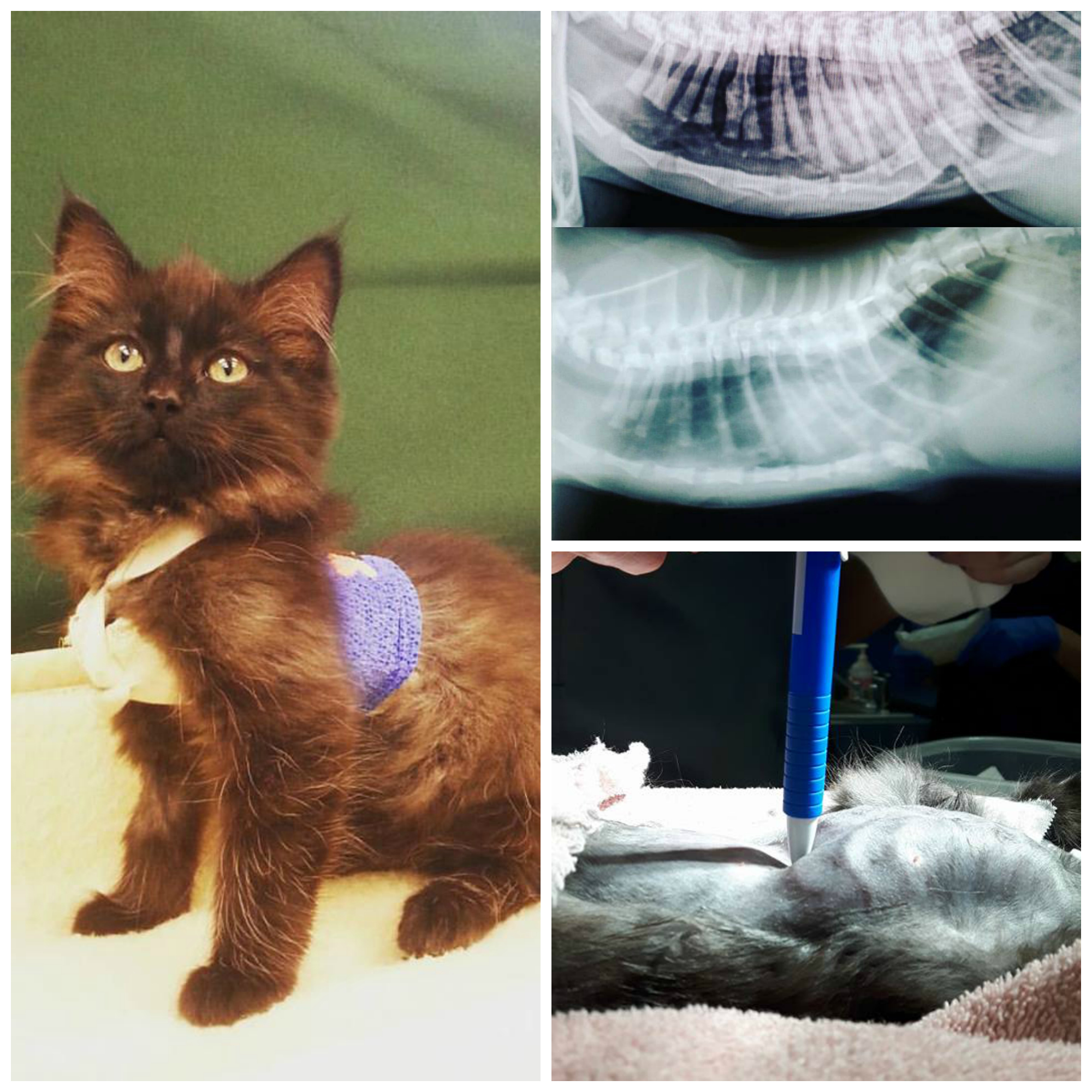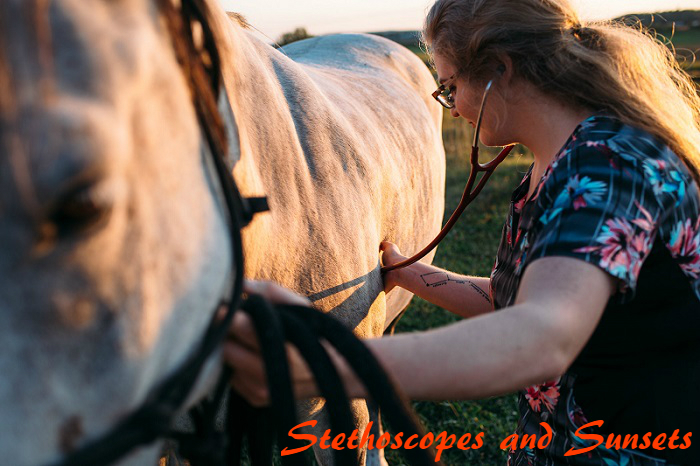
[Left: Domino rocking her body cast. Top right: before (top) and after xrays of her sternum. Bottom right: during surgery, using a pen to show the depth of the defect where her sternum was growing ‘in’ rather than ‘out’.]
Domino was a kitten I fostered who had a severe case of pectus exavatum, a condition where the sternum doesn’t grow correctly and instead damages the lungs. She stayed with me for months during her recovery and I became extremely fond of her.
She’s about six weeks old when I first meet her, a scruffy little mass of black fur and huge eyes just finishing the color change from blue to yellow and caught in some strange in-between of both. She’s almost half the size of her sleek dark sister and noticeably thinner with tiny toothpick ribs that jut between my fingers. I don’t have time to give her a full exam when she gets dropped off at work but she looks bright enough scarfing down a tin of kitten food that I figure it can wait until that night.
When I get home from work I check her sister first, confirm everything’s good. She’s of a good weight and already lithe with muscle, attempting to devour my hand as I inspect bright white needle-teeth. The girls at work have already christened her Blackjack (before knowing the sex) so her nickname becomes Jackie. I put her down, scoop up Domino. She’s been playing and she must have been playing hard because she’s almost gasping for breath, mouth open and pinkish tongue protruding. I frown. That’s not normal. I go to nestle her in one hand while I find my stethoscope and stop cold as my fingers slip into the defect in her chest wall.
The night after that becomes a blur of after-hours x-rays with a coworker who kindly stays late, sending pictures to the on-call vet who’s more comfortable in large animal than small and can only, helplessly tell me that it doesn’t look good. Her sternum is caved in, doubled in on itself and growing upwards towards the spine, her ribs awkwardly curved to support it. Her lungs are cramped, her diaphragm squeezed. Even at her most relaxed she breathes rapidly and frequently with her mouth open; when she tries to play her color flushes from bright pink to a horrible purple-blue. Pectus excavatum. Not a big deal in bipedal humans but rather more of a problem for our quadruped friends.
I go home, finally, and research instead of sleep. I build myself up a collection of surgical techniques and case studies before sending an email to another one of my vets who’s working part time at the clinic right now: I’ve got a weird surgical case: would you be okay trying it for me? We talk about the odds together, the chances of her living through the anesthetic, the procedure, the recovery, whether or not it will even work. She’s never tried before. I’ve never tried before. Finally she agrees with the caveat being that we all acknowledge the risks involved. The day before surgery I adopt her. The shelter can’t afford a risky Hail Mary surgical intervention on a kitten but with help from my work, I can. If she survives, I’ll find her a home. If.
The surgery is nervewracking. We have to be careful when we breathe for her not to expand her little lungs too far, unused to oxygen as they are. We shave her chest and when it’s bare the defect is exposed in all its ugly glory, an indent deep into her sternum like some divine hand has wrapped around, dug in a thumb, and squeezed. My vet chatters nervously as she loops thick ropes of suture around the sternum itself and begins the slow process of pulling it towards the chest wall, threading the suture through a body cast we’ve molded to her chest in hopes of tacking down the bones until they grow straight. The xrays after surgery don’t look bad, but they don’t look great either. We bandage the cast to her chest and place her in an oxygen chamber to wake up. She’s survived anesthesia and surgery: now she has to survive recovery.
The recovery is rough. She wakes panicking and blue, struggling to breathe and understand why her chest is bound. We sedate her again and let her float on an opioid sea, dazed but at least not thrashing. That night her lungs fill with fluid as they struggle to cope with breathing more deeply than ever before and I stay up most of the night injecting her with diuretics and sedatives, holding her, hoping. The next day and night go much the same and my hopes wither a little further. She sleeps the boneless sleep of the drugged nestled up against my neck, and I wonder if I should let her go.
The next day, I bring her to work to change her bandage. She lies limp on the table as I use blunted scissors to carefully cut off the elastic bandage covering her cast, checking for any signs of sores or rubs. Finding nothing I turn to grab a new roll of Vetrap only to here a sudden scuttle of claws. I whip around just in time to see her scooting cheerfully across the table, head and tail up and apparently bound headlong for the floor. It’s the most she’s moved in days. Shocked but delighted I quickly reapply her bandage, at which point she immediately falls to the table and goes limp once more, her eyes reflecting her great despair at being wrapped up.
Hmm.
A couple of hours and several bandage modifications later Domino is up and moving once more, gleeful as she plays with my shoelaces and gnaws on my thumb. That night she manages to climb the walls of her X-pen ‘medical confinement zone’ and wakes me up clawing at my face and begging to play. After that keeping her confined becomes an exercise in futility and I resign myself to frequent bandage changes as she hurtles around the house, enjoying her newly improved lung capacity.
The weeks pass quickly. She still goes blue if she plays too hard and at one point we use a large magnet to add weight to the bottom of the cast in hopes of pulling the sternum still-further down, leading to a great moment in which I hear screaming and leap up in terror only to discover my kitten magnetized to the bottom of the fridge. She begins to grow and the bandages become less and less elaborate as she fights them. She gains weight, her eyes change color fully. She goes from a spoiled tiny kitten to an incredibly spoiled larger kitten, kicking and screaming her way through physical therapy and bandage changes.
Finally, a week before the cast is due to come off, she takes matters into her own hands. I come home to find that she’s broken the top two sutures holding it to her chest and bring her into work to replace them, only to have her coil up her hind legs under her cast and literally kick it off of herself, tearing the last two sutures in a bloody mess that has me panicking and her zooming around in gleeful abandon, clearly pleased with herself. The xrays we take show that the sternum is much straighter than it was before and my vet and I decide the best thing to do for now is wait and see.
It pays off. I get to watch my tiny Domino go from a gasping, panting puddle of fur and bones to a sleek and somewhat plump teenage kitten who tears around my house after imaginary mice and tackles me in the night begging to play. She gradually pants less and less until one day I realize that I haven’t seen her collapse after playing in what seems like weeks. That night we cuddle on the couch and watch Netflix and I know, I know — it’s time. I’ve had her long enough and I don’t, I remind myself, I don’t keep my fosters (I’ll break this rule next year but for now, I stick to it), even if she is a fake one.
She goes to a lovely young woman I work with and I get to hear the stories of her terrorizing their home and other pets, a spoiled holy terror of a kitten who thinks she should get anything she wants. I proudly admit that was my fault — she was dying, I argue, what was I going to do? Not spoil her? — and take responsibility for the night-time toe ambushes and destroyed plants. A few months later she comes in for her spay and I’m shocked to see a fully adult cat, a mass of fluffy black fur and two huge yellow eyes, still pleasantly plump and still (sucking a bleeding finger after trying to sedate her) decidedly spoiled.
I take an x-ray on my own dime, curious, and see a nearly-straight sternum and wide, healthy lungs. Lungs that she’s using as I hear her shriek her displeasure at being caged; she never did like being confined. When she slips under the anesthesia her color is a bright, healthy pink and when she wakes up there’s minimal thrashing and not a single gasp. She’s fixed, I realize. We fixed her.
Or nearly, anyway. We dress her in a medical shirt to prevent her from licking her incision and I can’t help myself laughing as I see her flop boneless to the table, completely limp, the picture of despair and agony because we dared to wrap her up.
Some things don’t change.

One comment
hete moxifloxacin coverage enterococci liberation thu?c nh? m?t moxifloxacin – avelox nombre
comercial [url=https://canadapharmacy-usa.com/buy-avelox-usa.html]moxifloxacin nasal[/url] fischerei
avelox monographie